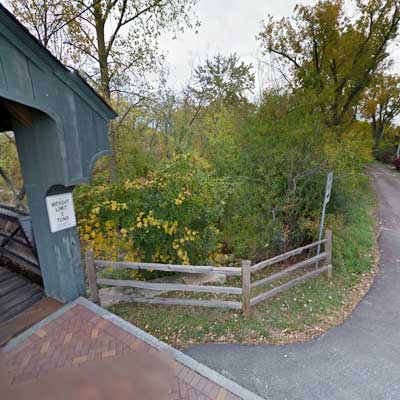The first bridge over Buffalo Creek in downtown Long Grove was a simple wooden affair, created in the late 1840's as a "less messy" way for area people to get to the church and cemetery – riding your horse through Buffalo Creek would have been the earlier "messy" way. It was likely a simple structure, but adequate for the occasional horse and wagon. It was not covered. As the population in the Long Grove area increased, the crossroads became a strategic central location for goods and services – by 1900 it had become a true commerce center for area farmers, featuring two corner stores, a creamery, a hotel, a tavern, and even a town hall. Long Grove was on the map.
In 1902, the automobile was just starting to take hold – one automobile for every 1000 people in the US. Where does one drive their car in a horse and wagon world? Not very far on dirt roads and certainly not alone - AAA was formed in Chicago in 1902 to advocate for road improvements. Clubs were formed for people to take excursions together. Long Grove was a popular early destination for these early adopter auto enthusiasts. Perhaps in a related response, the wooden bridge was replaced in 1906 with a more modern iron truss structure, which can be seen in the photo below.
Ironically, this burgeoning mobility would be the downfall of early downtown Long Grove, and later its revival. With the advent of the automobile and tractor, Long Grove lost its strategic location advantage – area residents no longer needed local horse and buggy shops, and were able to drive father to larger towns to do their weekly marketing and shopping. Some Long Grove shops closed up and sat empty, while others tried to adapt – the Smithy put in an auto garage and gas pump. The hotel was converted to a private residence. A chance for commercial redemption came and went in 1930, when the State routed Highways 53 and 83 around Long Grove. The rationing and economics of World War II pretty much finished off what was left. By 1945, Long Grove had become a ghost town – two dirt roads crossing with shuttered buildings all around.
When the economy improved after the war, so did the roads – Old McHenry Road was blacktopped and the corner stores were acquired by the wives of two local farmers who began selling antiques, handmade dresses, ice cream, and homemade pies. Long Grove again became an interesting and fun place to drive on a nice afternoon. Its growing popularity attracted the attention of a few other antique dealers and adjacent downtown residences were acquired and repurposed as additional shops. Recognizing that expansion could hurt the charm of the quant crossroads, action was taken in 1962 - the Long Grove Village Board passed the "Historic Landmark Ordinance", one of the first of its kind in the country. The ordinance required new construction and remodeling to conform to a certain historic style, known as the "Long Grove Style".
Imagine the year is 1967 and your wife has a toothache. What can you do to help take her mind off the pain? If you're John Mangel, you offer to take her for a drive over to this interesting little crossroads you've heard about called Long Grove. That's exactly what happed – on arriving John was amazed with how many shoppers there were and how few stores there were – these people needed more things to buy! An entrepreneur, John began acquiring additional buildings and residences in town and began converting them into additional stores. As fortune would have it, Long Grove's Village President at the time was Robert Parker Coffin – an engineer and builder by trade. Many new shops were built.
When the old truss bridge began showing its age, Lake County recommended that it be replaced with a culvert. Recognizing the opportunity to further the village's charm, it was proposed the life of the truss infrastructure be extended by covering it – a covered bridge. Village President Coffin chose a famous New England bridge – the Ashuelot, New Hampshire Bridge, as a model for his design for the new cover. So in 1972, Long Grove got its first covered bridge… or more accurately described… its first bridge covering. Since the bridge is a good spot to learn about used to be on the other side of the road, across the creek, you can press NEXT STOP now to continue your tour.


